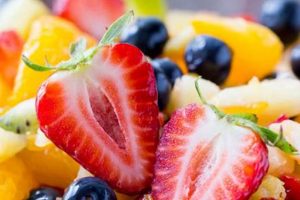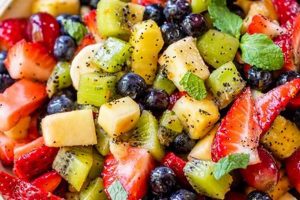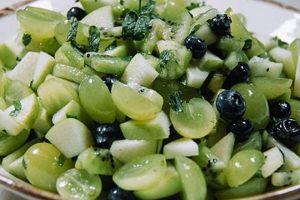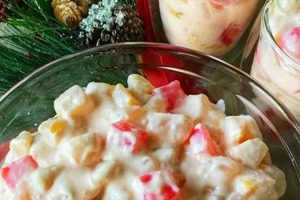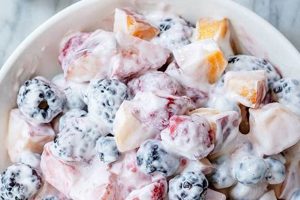Dishes encompassing flavored gelatin combined with various fruits offer a refreshing and often visually appealing dessert or side dish. These combinations range from simple mixtures of canned fruit cocktail in prepared gelatin to more elaborate creations incorporating fresh fruits, whipped cream, nuts, and even marshmallows. An example might include a blend of mandarin oranges, pineapple chunks, and maraschino cherries suspended in lime-flavored gelatin.
Such desserts gained popularity particularly in the mid-20th century, often appearing at potlucks, holiday gatherings, and other social occasions. Their appeal stems from the ease of preparation, affordability, and adaptability to diverse tastes and ingredient availability. The cool, jiggly texture and vibrant colors make them especially enticing in warmer weather. Furthermore, the inherent flexibility of the concept allows for creative variations, accommodating seasonal fruits and personalized flavor profiles.
This article will delve deeper into the world of gelatin-based fruit desserts, exploring variations, providing helpful tips for successful preparation, and offering suggestions for enhancing both flavor and presentation. Specific recipes will be showcased, demonstrating the versatility of this classic dessert category.
Tips for Creating Excellent Gelatin-Based Fruit Desserts
Achieving optimal results with fruit-gelatin combinations requires attention to several key factors. The following tips offer guidance for enhancing both flavor and texture, ensuring a successful and enjoyable culinary experience.
Tip 1: Fruit Selection and Preparation: Fresh, canned, or frozen fruits can be incorporated. Fresh fruits should be ripe but firm. Canned fruits should be well-drained. Frozen fruits should be thawed and any excess liquid discarded to prevent weakening the gelatin’s structure.
Tip 2: Dissolving the Gelatin: Complete dissolution of the gelatin granules is crucial for achieving the desired texture. Follow package instructions precisely, typically involving dissolving the gelatin in boiling water before incorporating cold liquid. Ensure no undissolved granules remain before adding other ingredients.
Tip 3: Mold Preparation: Lightly oiling the mold before adding the gelatin mixture facilitates easy removal. Alternatively, molds can be rinsed with cold water before filling.
Tip 4: Layering for Visual Appeal: Create visually appealing desserts by layering different colors of gelatin and fruit. Allow each layer to set partially before adding the next to prevent mixing.
Tip 5: Chilling Time: Sufficient chilling time is essential for the gelatin to set completely. Refrigerate for the time specified in the recipe, or until firm. Avoid freezing, as this can negatively impact the texture.
Tip 6: Unmolding Techniques: To unmold, briefly dip the mold in warm (not hot) water. Invert onto a serving plate. Gently shake or loosen the edges with a knife if necessary.
Tip 7: Flavor Enhancements: Experiment with flavor combinations by incorporating fruit juices, extracts, spices, or even a splash of wine or liqueur (for adult palates). Citrus zest adds a refreshing brightness.
By following these tips, one can elevate simple gelatin-fruit combinations into impressive and flavorful desserts suitable for a variety of occasions. Attention to detail and careful ingredient selection contribute significantly to the overall quality and enjoyment of the finished product.
This guidance provides a solid foundation for exploring the vast possibilities offered by gelatin-based fruit desserts. The following section presents specific recipes to inspire and guide further culinary endeavors.
1. Fruit Selection (Fresh, Canned, Frozen)
Fruit selection significantly impacts the final quality of a fruit jello salad. Each form fresh, canned, or frozen presents distinct advantages and challenges. Fresh fruit offers optimal flavor and texture but requires careful selection for ripeness and firmness. Overripe fruit can introduce excess liquid, compromising the gelatin’s structural integrity. Canned fruit provides convenience and consistent texture but may require draining to prevent excess syrup from affecting the gelatin setting process. Frozen fruit offers year-round availability and often a more vibrant color than canned options, but similar to fresh fruit, excess moisture from thawing must be managed.
The choice of fruit type also influences the overall flavor profile and visual appeal. Consider the complementary nature of fruit and gelatin flavors. For instance, tart berries pair well with lighter gelatins like lemon or lime, while sweeter fruits like peaches or mangoes complement richer flavors such as orange or cherry. Visual appeal is enhanced by selecting fruits with varied colors and textures, creating a visually dynamic presentation. A combination of red strawberries, green grapes, and yellow pineapple offers a striking color contrast within a clear or lightly tinted gelatin.
Ultimately, the optimal fruit selection depends on the desired outcome and practical considerations such as seasonality, budget, and preparation time. Understanding the characteristics of each fruit form empowers informed decisions regarding flavor pairings, texture management, and final presentation, ensuring a successful and enjoyable fruit jello salad.
2. Gelatin Flavors (Variety, Pairings)
Gelatin flavors play a crucial role in the overall success of fruit jello salad recipes. The diverse range of commercially available gelatin flavors, from classic options like lime, lemon, orange, and cherry to more exotic choices such as pineapple, mango, and berry blue, provides ample opportunity for creative exploration and flavor customization. Successful pairings depend on considering the inherent sweetness and tartness of both the chosen fruits and the gelatin flavor. A harmonious balance enhances the final product, while a mismatch can lead to a less palatable result.
Consider the interaction between fruit acidity and gelatin sweetness. Tart fruits, such as cranberries or raspberries, often benefit from pairing with sweeter gelatin flavors like strawberry or cherry. Conversely, sweeter fruits like bananas or mangoes may find a more balanced profile when combined with less sweet, perhaps even slightly tart, gelatin flavors like lime or lemon. Specific flavor pairings, like orange gelatin with mandarin orange segments, can create a cohesive and intensified citrus experience. Alternatively, contrasting flavors, such as lime gelatin with mixed berries, offer a dynamic interplay of sweet and tart notes. Experimentation remains key to discovering preferred combinations.
Effective flavor pairing extends beyond simply matching or contrasting flavors. It also considers the overall desired taste profile. For a refreshing, light dessert, a combination of citrus fruits and a light, complementary gelatin flavor might be preferred. A richer, more decadent dessert might call for the combination of sweeter fruits, a corresponding gelatin flavor, and the addition of elements like whipped cream or nuts. Understanding the interplay between fruit and gelatin flavors, and how these choices contribute to the final outcome, allows for informed decision-making and the creation of well-balanced and enjoyable fruit jello salad recipes.
3. Sweetness Level (Adjustments, Alternatives)
Sweetness significantly influences the palatability of fruit jello salad recipes. Careful management of sweetness levels ensures a balanced and enjoyable final product. Considerations include inherent fruit sweetness, added sugars in prepared ingredients like canned fruit, and the sweetness profile of the chosen gelatin flavor. Adjustments and alternatives allow for customization based on personal preferences and dietary restrictions.
- Inherent Fruit Sweetness
The natural sugar content of the selected fruits forms the foundation of the dessert’s sweetness. Ripe fruits contribute more sweetness than less ripe counterparts. The inherent sweetness of chosen fruits dictates the need for additional sweetening agents. Very ripe fruits might require less added sugar, while tart fruits necessitate adjustments to achieve the desired sweetness balance. Blending fruits with varying sweetness levels offers complexity and a more balanced flavor profile.
- Added Sugars in Prepared Ingredients
Many commercially available ingredients, such as canned fruits packed in syrup or flavored gelatin mixes, contain added sugars. Careful consideration of these pre-existing sugars prevents excessive sweetness. Opting for canned fruit packed in juice or light syrup minimizes added sugars, affording greater control over the final product’s sweetness. Examining product labels allows for informed decisions regarding added sugar content and facilitates appropriate adjustments during recipe preparation.
- Adjusting Sweetness with Sugar Substitutes
Sugar substitutes provide alternatives for individuals seeking to reduce sugar intake or manage dietary restrictions. Options include artificial sweeteners, natural sweeteners like stevia or honey, and sugar alcohols. Each option presents unique flavor profiles and potential impacts on the gelatin’s setting properties. Thorough testing and recipe adaptation may be necessary to achieve desired results when incorporating sugar substitutes. Understanding the characteristics of chosen substitutes ensures optimal flavor and texture outcomes.
- Balancing Sweetness with Acidity
Acidity serves as a counterpoint to sweetness, creating a more balanced and complex flavor profile. Incorporating acidic elements like citrus juice or zest brightens the dessert and prevents it from becoming overly sweet. Balancing sweetness and acidity enhances the overall sensory experience. The interplay between sweet and tart components elevates the flavor profile beyond a one-dimensional sweetness, adding depth and complexity to the final product.
Managing sweetness levels is crucial for creating palatable and enjoyable fruit jello salad recipes. Careful selection of ingredients, awareness of pre-existing sugars, and judicious use of additional sweetening agents or alternatives all contribute to a well-balanced final product that caters to specific preferences and dietary needs. The interplay between sweetness and acidity further enhances the overall sensory experience, demonstrating the multifaceted nature of flavor balance within this seemingly simple dessert category.
4. Textural Elements (Nuts, Marshmallows)
Textural contrast significantly enhances the sensory experience of fruit jello salad recipes. Incorporating elements like nuts and marshmallows introduces contrasting textures to the predominantly smooth, jiggly texture of the gelatin and the generally soft texture of the fruit. This contrast creates a more dynamic and engaging mouthfeel, elevating the dish beyond a simple textural experience. Nuts offer a satisfying crunch and potential flavor complexity, while marshmallows contribute a soft, airy lightness.
The choice of nuts depends on desired flavor profiles and aesthetic considerations. Toasted, chopped pecans or walnuts provide a robust, earthy flavor and a pronounced crunch, complementing richer fruit and gelatin combinations. Slivered almonds offer a delicate crunch and subtle flavor, suitable for lighter, brighter flavor profiles. Considerations extend beyond flavor; the size and shape of the nuts impact the overall presentation and eating experience. Smaller, finely chopped nuts distribute more evenly throughout the salad, while larger pieces offer a more pronounced textural contrast.
Marshmallows contribute a contrasting softness and a distinct sweetness. Miniature marshmallows distribute readily, while larger marshmallows create pockets of airy sweetness. The size and shape influence both the visual presentation and the textural experience. The inherent sweetness of marshmallows necessitates careful consideration of overall sweetness balance within the recipe. Overuse can lead to an excessively sweet final product, detracting from the intended flavor profile.
Careful consideration of textural elements elevates fruit jello salad recipes from simple to sophisticated. The interplay of textures creates a more dynamic and engaging culinary experience. Understanding the impact of various textural additions allows for informed choices that complement the chosen flavors and enhance the overall enjoyment of the dish.
5. Mold Shapes (Creative Presentation)
Mold shapes play a significant role in the presentation and perceived appeal of fruit jello salad recipes. Beyond basic functionality, mold selection offers an opportunity to enhance visual appeal and create a more engaging dining experience. The chosen mold shape influences portioning, serving style, and overall aesthetic impact. A simple change in mold shape can transform a standard fruit jello salad into a visually striking centerpiece or individual portions suitable for a more formal setting.
Traditional Bundt pans or ring molds create elegant presentations suitable for festive occasions. Individual ramekins or small bowls offer portion control and facilitate individualized servings. Novelty molds, shaped like fruits, animals, or other whimsical designs, add a playful touch, particularly appealing to children. The mold’s shape influences not only the final presentation but also the distribution of fruit pieces within the gelatin, affecting both visual appeal and the distribution of flavors and textures within each serving. A fluted mold, for instance, creates visually appealing ridges and valleys, while a smooth, geometric mold presents a more modern aesthetic. Intricate molds with detailed designs can further enhance the visual appeal, transforming the jello salad into a true culinary centerpiece.
Practical considerations also influence mold selection. Material impacts ease of unmolding and cleaning. Flexible silicone molds generally release the set gelatin more easily than rigid metal or plastic molds. Size determines the number of servings and the overall scale of the finished product. Selecting the appropriate mold shape requires consideration of both aesthetic goals and practical limitations. A balance between creative presentation and functional suitability ensures a successful and visually appealing fruit jello salad. The mold becomes an integral component of the recipe, contributing significantly to the overall sensory experience.
6. Chilling Time (Optimal Setting)
Chilling time directly impacts the structural integrity and overall quality of fruit jello salad recipes. Adequate chilling allows the gelatin to fully set, achieving the desired firm yet jiggly consistency. Insufficient chilling results in a weak structure, potentially leading to a soupy or runny salad that fails to hold its shape. Conversely, excessive chilling can make the gelatin too firm, resulting in a rubbery texture. Optimal chilling time, therefore, represents a critical balance, ensuring proper gelatinization while preserving a desirable texture.
Gelatin requires a specific temperature range and duration for optimal setting. This process, known as gelation, involves the formation of a three-dimensional network of protein molecules, trapping liquid within the structure. Lower temperatures promote this network formation, while higher temperatures inhibit it. Recipes typically specify a minimum chilling time, usually ranging from two to four hours, to ensure complete gelation. However, factors such as ambient temperature, refrigerator temperature, and the specific ingredients used can influence the required chilling duration. A colder refrigerator or the inclusion of ingredients that lower the freezing point, such as alcohol, may necessitate adjustments to the chilling time. Observing the salad’s consistency provides a practical gauge for determining readiness. A fully set jello salad should appear firm and jiggly, holding its shape when gently shaken. A soft, runny consistency indicates insufficient chilling, while an excessively firm, rubbery texture suggests over-chilling.
Understanding the relationship between chilling time and gelatin setting allows for predictable and consistent results. Careful adherence to recommended chilling times, coupled with observational assessment, ensures the desired texture and structural integrity of fruit jello salad recipes. This understanding enables successful preparation and contributes to a more enjoyable culinary experience. Failure to observe appropriate chilling times can lead to structural instability and compromised textural quality, detracting from the overall appeal of the dish.
7. Serving Suggestions (Garnishes, Accompaniments)
Serving suggestions, encompassing both garnishes and accompaniments, represent the final touch in presenting fruit jello salad recipes, elevating them from simple dishes to thoughtfully composed culinary creations. Consideration of these elements enhances visual appeal, complements existing flavors, and adds textural complexity, contributing to a more complete and satisfying dining experience. Garnishes provide visual interest and often a burst of fresh flavor, while accompaniments offer complementary textures and tastes, enhancing the overall enjoyment of the jello salad.
- Garnishes: Visual & Flavor Enhancement
Garnishes serve a dual purpose: enhancing visual appeal and adding bursts of fresh flavor. Fresh mint sprigs, a dusting of powdered sugar, or a sprinkle of citrus zest provide visual contrast and aromatic complexity. A dollop of whipped cream adds a touch of elegance and a contrasting textural element. The choice of garnish should complement the existing flavors of the jello salad without overpowering the primary flavor profile. A sprig of rosemary, for instance, might complement a citrus-based jello salad, while a few fresh berries would enhance a berry-flavored version.
- Accompaniments: Complementary Textures & Tastes
Accompaniments offer complementary textures and tastes, enhancing the overall dining experience. A scoop of vanilla ice cream provides a creamy contrast to the cool, jiggly texture of the jello salad. A side of crisp cookies or shortbread adds a contrasting crunch. The choice of accompaniment should consider the existing flavors and textures within the jello salad, aiming for a balanced and harmonious combination. A rich, creamy accompaniment might complement a lighter, fruit-forward jello salad, while a lighter accompaniment, such as a fruit coulis, might pair well with a richer, creamier jello salad.
- Plating Techniques: Elevating Presentation
Plating techniques significantly influence the visual appeal of the finished dish. A simple scoop of jello salad served in a small bowl can be elevated through thoughtful plating. Consider using contrasting colors and textures on the plate. A white plate provides a neutral backdrop for a vibrantly colored jello salad. A garnish placed strategically on the plate adds visual interest and directs the eye. The use of appropriate serving utensils, such as a small spoon or a decorative serving spatula, further enhances the presentation and contributes to a more refined dining experience.
- Contextual Considerations: Occasion & Audience
Serving suggestions should also consider the context of the meal. A simple, family-style meal might call for a less elaborate presentation than a festive gathering or a formal dinner party. The age and preferences of the intended audience should also influence serving choices. Children might appreciate playful garnishes and accompaniments, while adults might prefer more sophisticated options. Adapting serving suggestions to the specific context ensures a more appropriate and enjoyable dining experience for all.
Thoughtful consideration of garnishes, accompaniments, and plating elevates fruit jello salad recipes from simple desserts to carefully composed culinary creations. These elements enhance visual appeal, introduce complementary flavors and textures, and contribute to a more satisfying and memorable dining experience. The interplay of these components demonstrates that even seemingly simple dishes can benefit from attention to detail and thoughtful presentation.
Frequently Asked Questions
This section addresses common inquiries regarding the preparation and variations of fruit jello salad recipes. Clarity on these points aims to facilitate successful preparation and encourage culinary exploration within this versatile dessert category.
Question 1: Can sugar-free gelatin be used in these recipes?
Sugar-free gelatin can be substituted, but it may require adjustments to the overall recipe. Sugar contributes to the setting properties of gelatin, so using a sugar-free alternative might necessitate additional setting agents or a longer chilling time. Refer to the specific product instructions for guidance on usage and potential adjustments.
Question 2: How can weeping or syneresis in the finished product be prevented?
Weeping, or syneresis, occurs when liquid separates from the gelatin. This can be caused by several factors, including insufficient chilling time, excessive agitation during preparation, or the inclusion of certain fresh fruits that contain enzymes that break down gelatin. Ensuring proper chilling, gentle handling, and pre-treating certain fruits (e.g., pineapple) by briefly heating them before adding to the gelatin mixture can help mitigate this issue. Additionally, following the gelatin instructions closely helps ensure proper setting and prevents syneresis.
Question 3: What are suitable substitutions for whipped cream?
Alternatives to whipped cream include Greek yogurt, coconut cream, or even a combination of softened cream cheese and powdered sugar. These options provide varying textures and flavors that can complement different fruit and gelatin combinations. Select based on desired flavor profiles and dietary considerations.
Question 4: Can alcohol be incorporated into fruit jello salad recipes?
Alcohol can enhance flavor complexity in adult-oriented variations. However, excessive alcohol content can inhibit gelatin setting. Use sparingly, incorporating small amounts of wine, liqueur, or flavored extracts to enhance flavor without compromising the structural integrity of the gelatin.
Question 5: How can one ensure even fruit distribution throughout the mold?
Even fruit distribution is achieved by partially setting the gelatin before adding denser fruits, which tend to sink. Allowing the gelatin to partially set creates a thicker base that better supports the fruit, preventing it from settling entirely at the bottom of the mold. Gently folding in the fruit and ensuring adequate chilling time also promotes even distribution. For layered salads, allow each layer to set fully before adding the next.
Question 6: How long can a fruit jello salad be stored?
Properly stored, fruit jello salad can typically be refrigerated for up to three to five days. Cover tightly to prevent drying and absorption of odors from other refrigerated items. Avoid freezing, as this can negatively affect texture and lead to syneresis upon thawing.
Addressing these common questions aims to provide a foundation for successful preparation and encourage experimentation with various flavors, textures, and presentations. Mastery of these basics empowers culinary exploration and enhances the overall enjoyment of fruit jello salad recipes.
For further exploration, consider the following resources and recipe variations.
Fruit Jello Salad Recipes
Exploration of fruit jello salad recipes reveals a deceptively complex landscape of flavor pairings, textural considerations, and presentation techniques. Successful execution hinges on understanding the interplay between fruit selection, gelatin flavors, sweetness management, and the incorporation of contrasting textural elements. Careful attention to chilling times and mold selection ensures structural integrity and enhances visual appeal. Serving suggestions, encompassing garnishes and accompaniments, further elevate these dishes, transforming simple combinations into thoughtfully composed culinary creations. Mastery of these elements allows for adaptation and customization based on individual preferences and dietary needs.
Fruit jello salad recipes, often perceived as simple desserts, offer significant potential for culinary creativity and personalized expression. Further exploration and experimentation within this versatile category promise continued enjoyment and discovery for both novice and experienced cooks. The enduring popularity of these dishes underscores their adaptability and inherent potential for culinary innovation.

